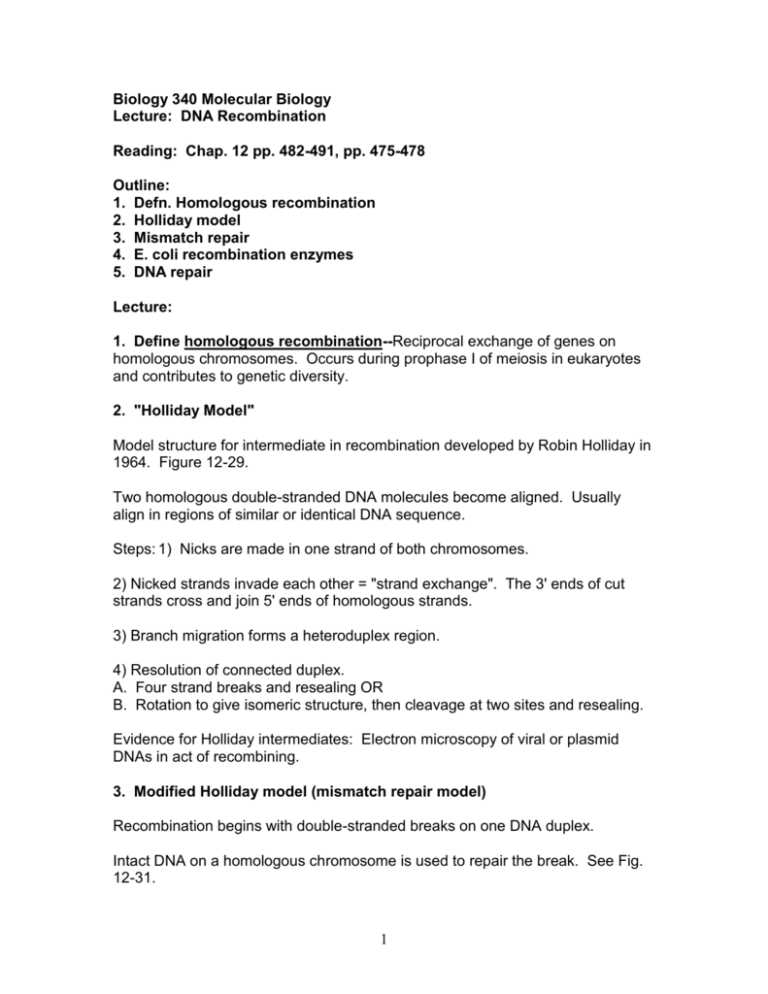Biology 340 Molecular Biology
advertisement

Biology 340 Molecular Biology Lecture: DNA Recombination Reading: Chap. 12 pp. 482-491, pp. 475-478 Outline: 1. Defn. Homologous recombination 2. Holliday model 3. Mismatch repair 4. E. coli recombination enzymes 5. DNA repair Lecture: 1. Define homologous recombination--Reciprocal exchange of genes on homologous chromosomes. Occurs during prophase I of meiosis in eukaryotes and contributes to genetic diversity. 2. "Holliday Model" Model structure for intermediate in recombination developed by Robin Holliday in 1964. Figure 12-29. Two homologous double-stranded DNA molecules become aligned. Usually align in regions of similar or identical DNA sequence. Steps: 1) Nicks are made in one strand of both chromosomes. 2) Nicked strands invade each other = "strand exchange". The 3' ends of cut strands cross and join 5' ends of homologous strands. 3) Branch migration forms a heteroduplex region. 4) Resolution of connected duplex. A. Four strand breaks and resealing OR B. Rotation to give isomeric structure, then cleavage at two sites and resealing. Evidence for Holliday intermediates: Electron microscopy of viral or plasmid DNAs in act of recombining. 3. Modified Holliday model (mismatch repair model) Recombination begins with double-stranded breaks on one DNA duplex. Intact DNA on a homologous chromosome is used to repair the break. See Fig. 12-31. 1 Key features: A. double-stranded breaks of one DNA B. exonuclease (5'->3') extends breaks to form gaps C. invasion of strand and formation of loop in uncut duplex D. DNA repair occurs: DNA polymerase extends 3' hydroxyl paired to template E. other strand of DNA is repaired F. broken strands are ligated to form two Holliday structures G. cleavage of Holliday structures leads to recombinant or non-recombinant duplexes H. Repair of mismatch in recombinant duplex can lead to gene conversion-produces a non-Mendelian ratio of alleles at a site of recombination Gene conversion: Usually observed in fungi as a non-Mendelian segregation pattern during meiosis (3:1 or 1:3, rather than 2:2). A x a (cross two haploids) Aa (diploid) Meiosis Usually get 2A:2a A A a a Gene conversion can get 3A:1a or 1A:3a A A A A a a a a 2 4. E. coli recombination proteins Rec BCD enzyme--Enzyme complex consisting of proteins encoded by Rec B, C and D genes. Works as a helicase and exonuclease to initiate recombination. --binds to double-stranded break in DNA --moves along DNA, helicase unwinds strands --when it reaches certain sequences on DNA (CHI site), it pauses generating a single strand with a 3' hydroxyl end Rec A protein--Binds to single-stranded DNA in the presence of ATP and helps mediate strand invasion and formation of a Holliday structure. Works after Rec BCD enzyme in E. coli recombination. Note that many E. coli strains used for genetic engineering are recA- to minimize recombination that might occur between the plasmid and the chromosome. Ruv A and Ruv B--Proteins that mediate branch migration and resolution of Holliday structures. Ruv C--Endonuclease that resolves the Holliday structure. 5. Repair of DNA damage DNA damage: --induced by chemicals that react with DNA --induced by ultraviolet radiation or X-rays Unrepaired DNA damage --in germ cells (egg, sperm) leads to mutations. --in somatic cells can lead to mutant tumor suppressor genes and oncogenescancer DNA repair mechanisms a. mismatch repair b. excision repair Mismatch repair: --E. coli MutHLS system (one of several repair systems) --eukaryotic homologs have been identified; these are tumor suppressors Figure 12-24 Key features: 1) MutS protein binds to site of mismatch 3 2) MutH protein binds to methylated (parental) strand in duplex 3) MutL protein activates endonuclease activity of MutH which cleaves opposite methyl group on daughter strand 4) daughter strand containing mispaired base is excised, gap is repaired and strand is methylated Excision repair: --This system is used to repair thymine dimers caused by UV damage or by attachment of large chemical groups to DNA. --E. coli UvrABC system See Fig. 12-26 Key steps: 1) Form complex of UvrA and UvrB proteins (ATP required) 2) Complex moves along DNA, locates a distorted region 3) Complex forms a kink in DNA 4) UvrC binds and UvrA leaves 5) UvrC nicks the DNA 6) UvrC and UvrB dissociate, helicase II unwinds DNA 7) gap is filled by DNA polymerase I and ligase 4








